Rose ‘Desdemona’ in the midsummer garden.
Such a morning it is when love leans through geranium windows and calls with a cockerel’s tongue. When red-haired girls scamper like roses over the rain-green grass, and the sun drips honey.
Laurie Lee, ‘Day of These Days’ (extract)
Hello, and welcome to this combined Full Moon, Summer Solstice and Midsummer edition of Bracken & Wrack. I’m writing this on St John’s Day, a tide brim-full of magic, beloved of the Fair Folk, when everything is a-shimmer.
My intention during these long warm summer days was to keep the new and full moon newsletters simple. I think that I have - sort of - in that this edition is something of a midsummer miscellany, drawing on words and pictures from midsummers past as well as from the last few vivid days. Let’s see what happens (because I don’t know yet either!) but my hope is that through these coloured scraps a patchwork quilt will emerge whose stitches catch just a glimpse of this moment at the top of the wheel when the earth stands in its fullness.
Summer Solstice sunrise at Happisburgh, 21 June 2022
HIDING AMONG THE LEAVES
I first saw this carving in Little Dunham church several years ago. It’s really big and it’s very prominently positioned high up in the nave. I was haunted by it afterwards. My initial impression was that it was a kind of Green Beast surrounded by leaves. Perhaps an ox? The church leaflet made reference to the Beast and even admitted it was somewhat pagan looking.
I’d come across other Green Beasts in Norfolk churches, like the Green Cats at Castle Rising and even a Green Rabbit (no, probably not really intended as a rabbit!) at Aldeby. The Aldeby carving even had spirals of vegetation emerging from the mouth in classic Green symbolism. This one did not, but traces of original colour remained on the leaves surrounding the Dunham Beast and it was a large and strange presence. I couldn’t begin to imagine its relevance in a church, but still I accepted it for what I thought it was.
Fast forward a few years and I went back to photograph the carving for a talk I was giving called Land of Faunus? In search of the horned god of Norfolk. That meant looking at every detail minutely, and suddenly I realised that this wasn’t an ox at all. The fringe between the horns, the ears, the eye. Ohh actually he’s the strangest horned Green Man you ever saw - 18 June 2018
Horned green being, Little Dunham church, Norfolk.
Owl-faced Lady,
Fox-masked Lord,
Fair Queen of Elphame,
Elven King,
Horned One,
Lady of Beasts,
Lord of the Wood,
Great Enchantress,
Oberon and Titania,
Merlin and Morgan,
Robin and Marian,
We gather this
Midsummer’s night
To do ye honour.
Michael Howard, ‘Midsummer Day: the Rite of Faerie’ (extract), Liber Nox
Solstice morning beach ceremony, 21 June 2023.
NOT IN THIS WORLD, AS THEY SAY, BUT IN NORTHFOLK
Last night I was here in the ruined Priory of St Mary in the Meadow at Beeston Regis, Norfolk, for Midsummer Solstice yoga.
I found this quote on the information board among the ruins:
NOT IN THIS WORLD, AS THEY SAY, BUT IN NORTHFOLK .
It was written in 1422, referring to St Mary in the Meadow, at a time when Norfolk was so remote it was like a foreign land to people in other parts of Britain.
Afterwards we climbed up Beeston Bump to see the Solstice sun set over the sea. So lucky, so lovely - 22 June 2018
Yoga in the peaceful ruins of St Mary in the Meadow before climbing Beeston Bump, Midsummer Solstice, 21 June 2018.
THE MIDSUMMER CUSHION
For many of us, the Midsummer Solstice seems the obvious point to be marked as a pivotal moment as the wheel turns on its yearly axis. From now on, we will slowly slide towards the Equinox and the time when day and night again become equal. Unlike saints’ feast days, it’s an astronomical event that happens when it happens, roaming completely free of any human-imposed calendrical date. As soon as you start looking at prehistory you are immediately struck by the way that our ancestors used landscape features as calendars and hauled huge stones into place to anchor the energies as they themselves made their astronomical observations. And surely had their own ways of commemorating this moment that impacted every aspect of their lives in the unfolding yearly cycle.
But if you know Bracken & Wrack you won’t be surprised to hear that I’m also fascinated by the ways of our medieval and more recent ancestors, especially the magical traditions of the wise-folk. And in medieval times - as Lia Leendertz reminds us in her very useful Almanac - ‘midsummer’ was a loose community celebration that ran between St John the Baptist’s Eve on 23 June and St Peter & St Paul’s Day on 29 June. And I would add, actually until St Thomas’ Day on 3 July, as celebratory midsummer bonfires were lit, and feasts and plenty of drink consumed, on all three of these dates.
Everything hinged upon St John’s Day itself, 24 June, as this was the date considered to be Midsummer Day - and therefore the date Shakespeare alludes to in A Midsummer Night’s Dream.
According to Lia, all the festivities were centred around fires, flowers and feasting. Doors were hung with birch, fennel, lilies and wild flowers (and, I believe, protective plants like St John’s wort, chamomile and mugwort). In the evenings bonfires and lamps would be lit outside workplaces and homes, food and drink laid out on tables, and neighbours invited to partake.
A tradition I had not heard of until I read about it in The Almanac is that of making ‘midsummer cushions’, which were the children’s floral contribution to these enchanted days. Some were made from a board smeared with clay or mud and then stuck all over with petals, and some from an actual cushion that was threaded with wild flowers.
The Northamptonshire nature poet John Clare said that children would take a piece of ‘greensward’ (turf) and stick it with meadow flowers to place in their cottages as a celebration of this most abundant moment in the year. He even entitled one of his poetry collections Midsummer Cushion, and the custom has been revived in his native village of Helpston. There, rather wonderfully, local children create midsummer cushions to decorate the poet’s grave on the weekend closest to his 13 July birthday.
So that’s an idea I might try - and you might like to as well - so please let me know if you give it a go. Once you start thinking about it there are lots of possibilities for ways to craft your own magical midsummer cushion, and as you can see you’re definitely not too late.
Another piece of folklore I discovered via The Almanac is the tradition of marking St Barnabas Day as the Longest Day, in much the same way that St Lucy’s Day is linked with the shortest, at the Midwinter Solstice. Before the change to the Gregorian Calendar in 1752, St Barnabas’ Day on 11 June used to fall on or close to the Midsummer Solstice:
Barnaby bright, Barnaby Bright
The longest day and the shortest night.
When St Barnabas smiles both night and day,
Poor ragged robin blooms in the hay.
The reference to ragged robin blooming in the hay is a reminder that St Barnabas Day was also traditionally the first day of haymaking:
'On the day of St Barnabas
Put the scythe to the grass’
My trusty little Observers Book of Wild Flowers has lovely illustrations including this one of ragged robin, one of my favourites.
Back to St John’s Day, and it’s interesting to note that the cuckoo, herald of spring, is said to sing from St Tibertius’ Day on 14 April to St John’s Day on 24 June:
‘If the cuckoo sings after St John
The harvest will be late’.
This piece of lore is clearly rooted in observation as if the cuckoo starts and finishes singing late it means that the whole season is a delayed one, thereby having a knock-on effect on the harvest.
I can make no promises that you won’t hear another cuckoo this year where you are. But I can tell you that the last time we picked up that wonderful totem sound of summer here in Norfolk (for only the second time this year, sadly) was on 20 June up at the coast near Brancaster - so luckily that one crept in under the wire.
And honoured among foxes and pheasants by the gay house
Under the new made clouds and happy as the heart was long,
In the sun born over and over,
I ran my heedless ways,
My wishes raced through the house high hay
And nothing I cared, at my sky blue trades, that time allows
In all his tuneful turning so few and such morning songs
Before the children green and golden
Follow him out of grace
Dylan Thomas, ‘Fern Hill' (extract)
And then the tide went out, and there on the sand was the most perfect Mermaid's Purse I've ever seen.
TASTING THE HIGH SALTY AIR
I probably discovered the abandoned caravan site by accident, or maybe a friend told me about it. When I first walked along the wild cliff top before crossing the neat car park and scrambling down to the beach, some of the burned-out remnants still stood there. Each rectangular standing was visible; some even had stepping stones to a long-gone door or beach cobbles arranged to outline a ghostly garden.
Dotted between the swathes of plantain, yarrow and wild grasses that were already making their takeover bid, were tossed heaps of debris. Broken paving slabs, drainpipes, breeze blocks, twisted bits of caravan chassis.
Sticking out, or balanced on top, were poignant reminders of the lives of the people who had loved their cliff top caravans. Scraps of Lino and tile, a doormat, a toilet bowl, a rusted barbecue.
Then there was the sole survivor. During my early visits to the cliff top a single caravan remained, the one furthest from the gate, derelict but not yet broken. It broke my own heart to look at it. I can hardly imagine how you would feel if you’d known the site - sea sparkling below, gulls wheeling above - in its heyday.
In time all the debris was cleared away and the buttercups and ragwort were free to roam where they would. But beautiful as the wildflowers are, they are not alone in tasting the high salty air of the cliff top. Here and there, patches of colour jump out and reveal that not all of the site’s inhabitants left when the last caravan was cleared away. Against the odds, cultivated plants mark the positions of once-loved gardens; tenacious floral tributes to a fragile paradise.
I have seen the green spears and fiery flowers of crocosmia, cottage-orange marigolds and dusky-bruised hydrangeas, their papery bracts set rustling by the east wind.
One autumn evening in the half-light my attention was caught by a distant splash of deep pink, a strange almost otherworldly hue. As I drew closer to the boundary hedge my heart jumped as I realised it was a rose, a cultivated rose unlike any I’d seen before. The bush itself was struggling, straggling, salt-burned and leggy but those scattered blooms had heeded a primeval call to spiral open, raising perfect petal-chalices in a toast to the glory days when the rose was lovingly planted and tended.
The rewilding of the cliff is now nearly complete and most of the hints of its former life have now gone. But not all.
I felt the rose needed a name so I call it the Gypsy Rose. I say ‘call’ rather than ‘called’ because - closer to the edge each year and holding on by a thread - the Gypsy Rose blooms there still.
A gypsy rose bloom in a Kestrel’s Eye candle vessel whose stories were set on the cliff top. Sunset at Happisburgh, 24 June 2022.
A Midsummer Gypsy Cake: Marrikli
This is the simplest cake recipe in the world. What transforms it into something magical is cooking it in a frying pan or on a griddle over an open Midsummer fire - or at a pinch over a little camping stove in any magical place. I believe it to be an authentic Romani recipe, although I’ve tweaked it from one that was given in The Almanac 2021 by Lia Leendertz to make a vegan version.
Rub 125g vegan baking block (hard fat) like Stork or a vegan ‘butter’ into 450g self-raising flour. Add 125g sultanas or currants (I feel currants are more traditional) and enough water to form a stiff dough. Here you could add some spices if you have some, although Romani people may not have done this.
Knead lightly and roll out to 5mm thick on a floured surface. Lightly grease a large frying pan or griddle, then place the cake into the pan, turning frequently until it is firm and golden. Test with a skewer to make sure it’s cooked through.
Serve with vegan spread and some maple syrup or drizzle with olive oil and sprinkle on some coconut sugar. (Needless to say, these last suggestions are far from traditional - the Marrikli would simply be spread with butter.)
We nestled our staffs into Weybourne’s pebbles on Solstice morning. Distant drumming in the air, coffee and breakfast on the beach in the offing. 21 June 2024.
Until next time.
With love, Imogen x





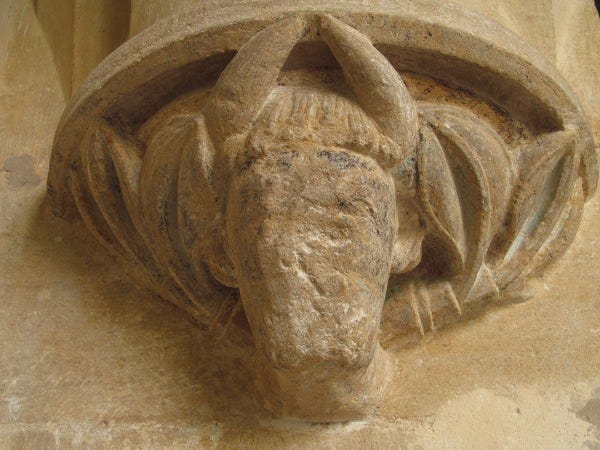

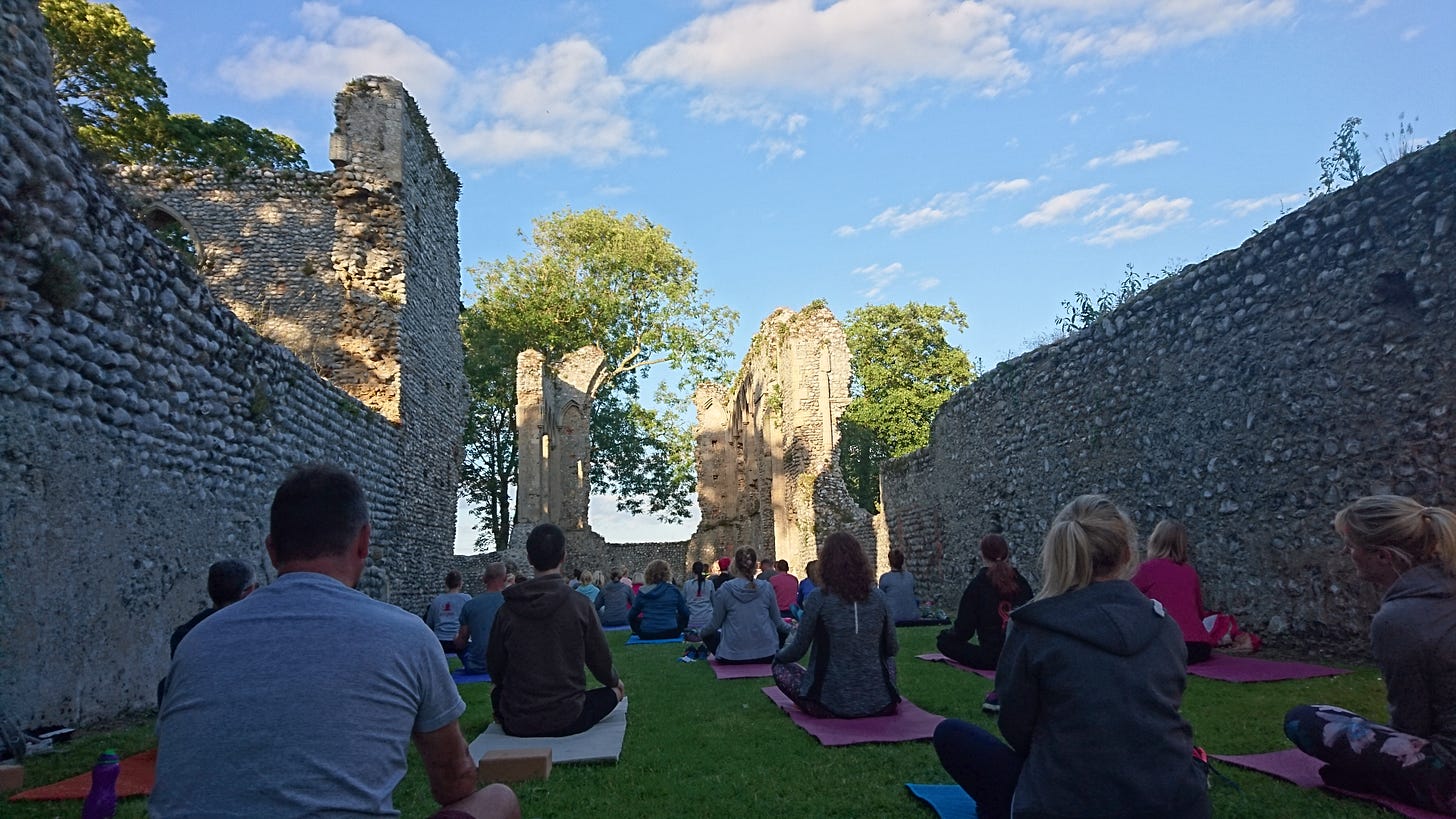
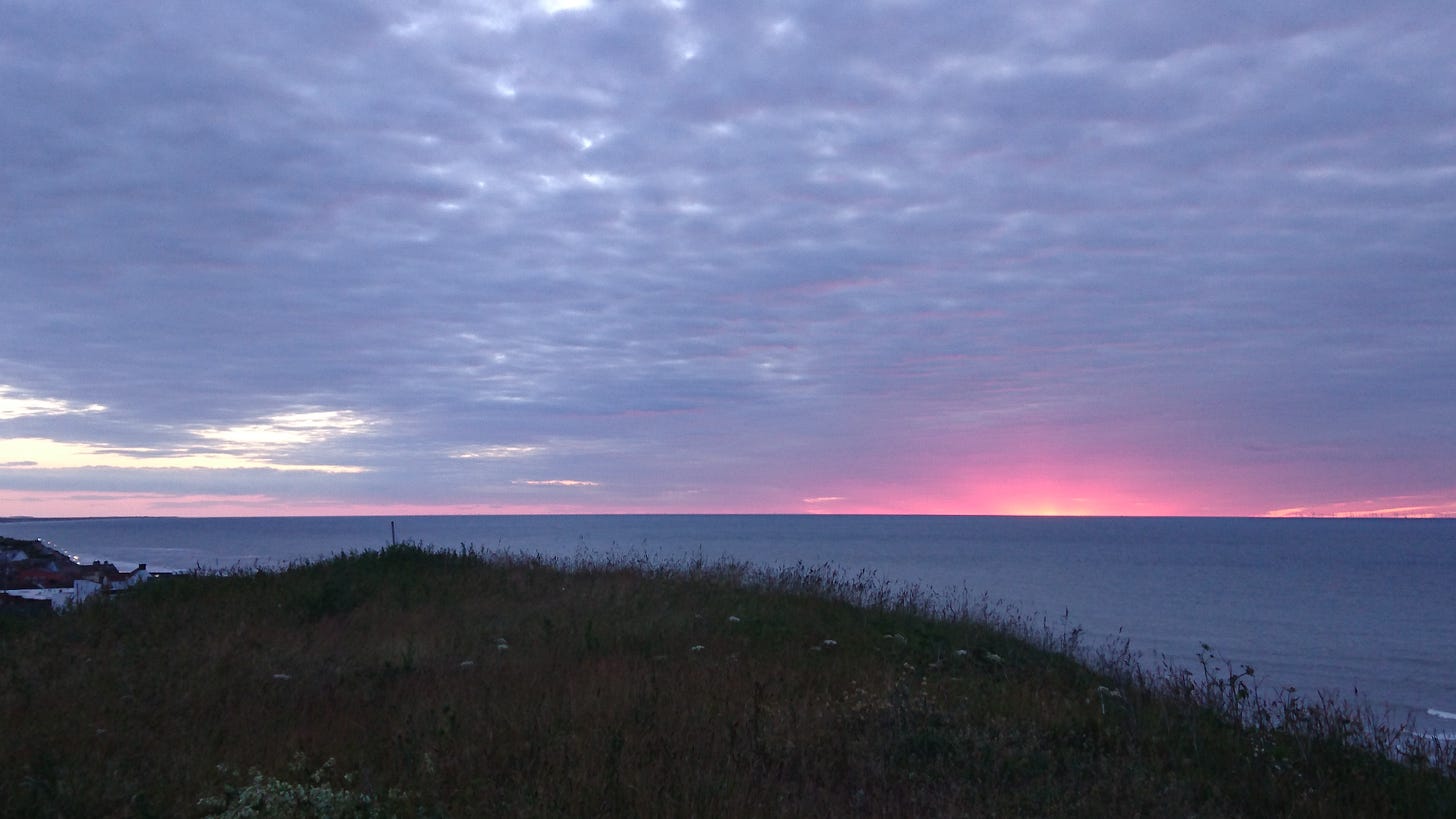

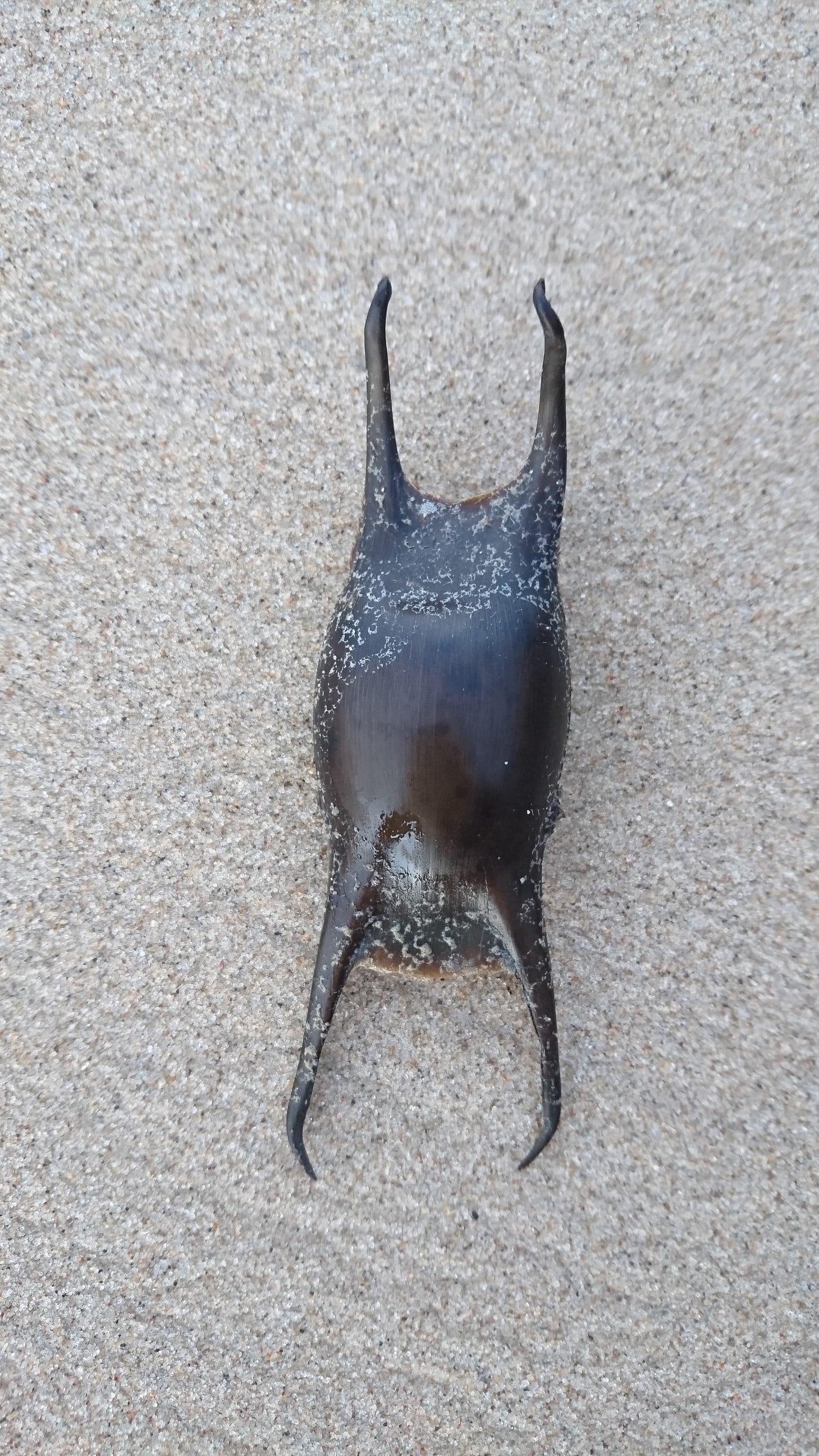
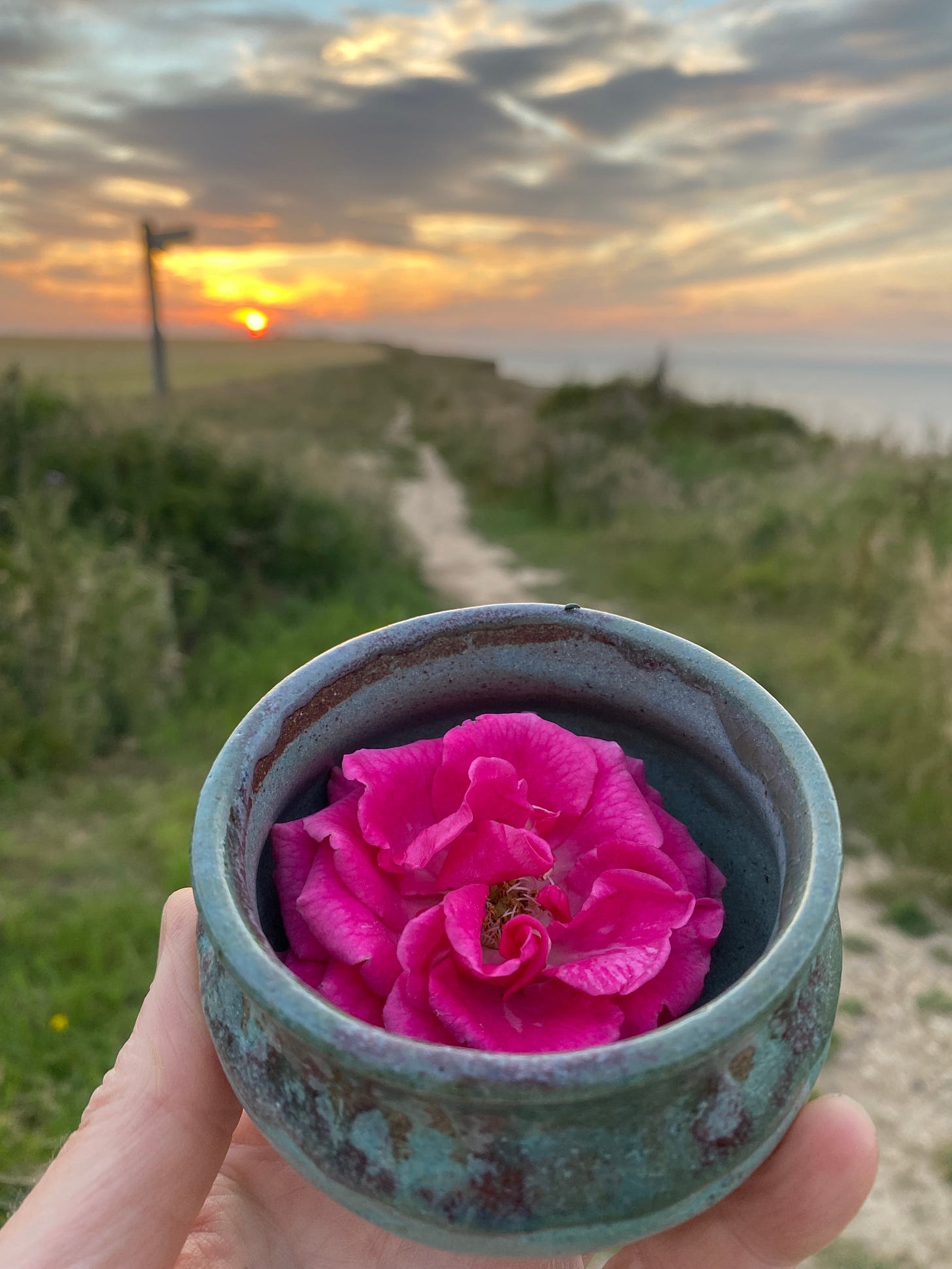

Slightly belated solstice and midsummer blessings to you Imogen 🌻. How lovely to read your words about summer traditions and the very touching description of the ‘gypsy rose’ still blooming at the old caravan site.
Thankyou Imogen for the most delightful post. I loved every bit of it and look forward to making the cake when midsummer comes, once again to me in my wobbly upside down world xxx